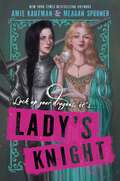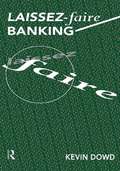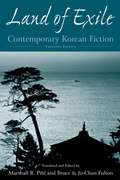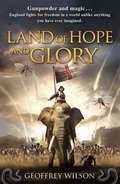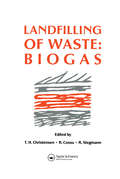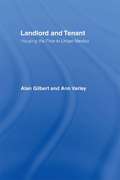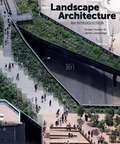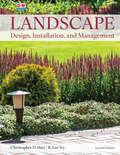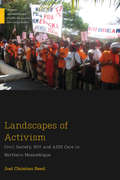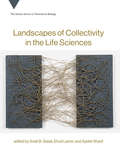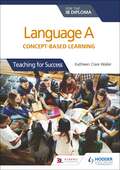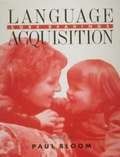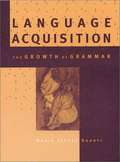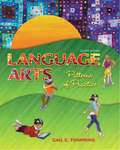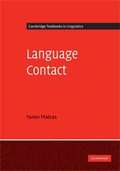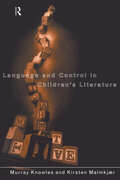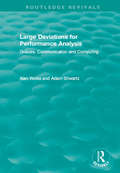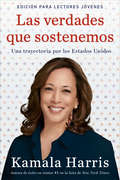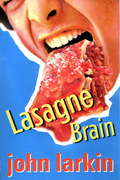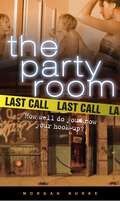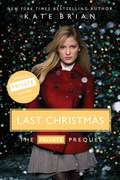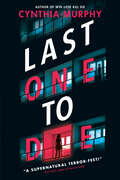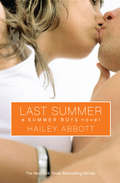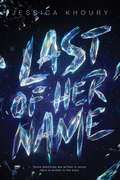- Table View
- List View
Lady's Knight
by Amie Kaufman Meagan SpoonerAn undeniably fierce, unforgettably funny, unapologetically queer feminist romp through the England of medieval legend. Bestselling and acclaimed authors Amie Kaufman and Meagan Spooner bring readers along on an epic quest for valor, freedom, and, above all, love. A Knight’s Tale meets the Lady Jane series, with a dash of The Great!Gwen is sick of hiding—hiding the fact that she’s taken over her father’s blacksmithing duties, hiding her attraction to girls, hiding her yearning for glory as a knight.Meanwhile, Lady Isobelle of Avington, queen bee of the castle, has never once considered hiding who she is—until now. She’s been chosen as the grand prize in the Tournament of Dragonslayers, to be given to whichever knight can claim her hand. And for the first time in her life, she can’t talk her way out of trouble.When Isobelle discovers Gwen’s knightly ambitions, they hatch a scheme together—Gwen will joust in the tournament, disguised as Sir Gawain. Winning means freedom for Isobelle, and glory for Gwen. Losing means… well, let’s not go there.One thing’s for sure: Falling in love was never the plan.But the best laid plans…are often trampled all over by dragons."A sapphic delight, full of jousts, jaunts, and courtly love. Lady's Knight sparkles with wit and charm and has lady knights to swoon over. Kaufman and Spooner will leave you breathless." —C. S. Pacat, New York Times bestselling author of Dark Rise“Kaufman and Spooner are auto-buy authors for me, always guaranteed to get my heart pumping with their page-turning romance and high-stakes adventure.” —New York Times bestselling author Susan Dennard"There are a lot of damsels in Lady's Knight, but none of them need a man to fix their problems. (Men seem to be the source of the problems, in fact.) Wholesome, heartfelt, and more fun than cheesecake on a stick, Kaufman and Spooner's latest book is all about women's work. You know, jousting, dragonslaying, and saving the kingdom—all while looking fabulous." —Jodi Meadows, coauthor of the New York Times bestselling novels My Lady Jane and My Plain Jane“Clever, funny, thrilling, and romantic—Lady’s Knight will inspire readers to take up their swords to fight dragons and the patriarchy. Perfect for fans of A Knight’s Tale and anyone who loves a romantasy with wit, charm, and the occasional comedic fourth wall break.” —F. T. Lukens, New York Times bestselling author of So This Is Ever After"You'll laugh, you'll cry, and you'll be ready to fight any dragon after reading this delightful tale full of swoony romance, heart-racing action, and the very best banter in the realm!" —Beth Revis, New York Times bestselling coauthor of Night of the Witch"Writing that is above all else marvelously warm and at the same time witty, adventure and romance that will sweep you off your feet—a double sweep, and a triumph!" —Sarah Rees Brennan, #1 Sunday Times bestselling author of Long Live Evil"Sparkles with wit and romance! So many quotable lines. Not to mention the sexiest gown-lacing scene in modern literature. Like its characters, Lady's Knight is endlessly clever and resourceful." —Ellen Kushner, award-winning author of Swordspoint
Laissez Faire Banking: Theory, History, And A Laissez-faire Model (Routledge Foundations Of The Market Economy Ser.)
by Kevin DowdThe idea of free (or laissez-faire) banking has enjoyed a remarkable renaissance in recent years. It is a novel idea that challenges much of what many banking scholars still take for granted - that banking is inherently unstable, that the banking system needs a lender of last resort or deposit insurance to defend it in a crisis, and that the Govern
Land of Exile: Contemporary Korean Fiction
by Bruce Ju-Chan Fulton Marshall R. PihlAn anthology of contemporary Korean fiction including: "The Wife and Children"; "The Post Horse Curse"; "Mountains"; "Kapitan Ri"; "The Winter"; and "A Dream of Good Fortune".
Land of Hope and Glory
by Geoffrey WilsonIt is 1852. The Indian empire of Rajthana has ruled Europe for more than a hundred years. With their vast armies, steam-and-sorcery technology and mastery of the mysterious power of sattva, the Rajthanans appear invincible. But a bloody rebellion has broken out in a remote corner of the empire, in a poor and backward region known as England. At first Jack Casey, retired soldier, wants nothing to do with the uprising, but then he learns his daughter, Elizabeth, is due to be hanged for helping the rebels. The Rajthanans offer to spare her, but only if Jack hunts down and captures his best friend and former army comrade, who is now a rebel leader. Jack is torn between saving his daughter and protecting his friend. And he struggles just to stay alive as the rebellion pushes England into all-out war.
Landfilling of Waste: Biogas
by T. H. ChristensenLandfilling of Waste: Biogas is the third in a series of reference books which provide a comprehensive overview of the state of the art and identify new directions in landfill technology and landfill research. As well as describing gas generation and composition, the book covers the environmental aspects, discusses gas production, extraction and transportation, treatment and utilization, emissions and safety, and ends with a selection of case studies.
Landlord and Tenant: Housing the Poor in Urban Mexico
by Alan Gilbert Ann VarleyThis ground-breaking work employs survey data and in-depth interviews to compile a detailed picture of landlords and tenants in developing countries. Focusing on Mexico the authors examine the state's housing policy, with its clear bias towards increasing home ownership, and explores the possibilities of improving the quality and increasing the stock of rented accommodation in the developing World.
Landscape Architecture: An Introduction
by Robert HoldenAimed at prospective and new students, this book gives a comprehensive introduction to the nature and practice of landscape architecture, the professional skills required and the latest developments.After discussing the history of the profession, the book explains the design process through principles such as hierarchy, human scale, unity, harmony, asymmetry, colour, form and texture. It looks at how design is represented through both drawing and modelling, and through digital techniques such as CAD and the use of GIS (Geographic Information Systems). This is followed by an examination of project management and landscape management techniques. Finally, the book explores educational and employment opportunities and the future of the profession in the context of climate change and sustainability.Illustrated with international examples of completed projects, Landscape Architecture provides an invaluable, one-stop resource for anyone considering studying or a career in this field.
Landscape: Design, Installation, and Management
by Christopher D. Hart R. Lee IvyLandscape Design, Installation, and Management provides an exciting, full-color, and highly illustrated learning resource with over 1,000 images, including illustrated glossaries of tools, equipment, ornamental landscape plants, and plant pests and diseases. Featuring up-to-date coverage of today's landscape industry, this text engages students with practical information on the principles and elements of design, pricing landscape projects and earning a profit, and workplace skills. The text methodically develops an understanding of Green Industry practices, safety, design principles, design processes, producing and selecting plants, the business side of landscaping, and landscape installation and maintenance. New Career Connection interviews with industry professionals provide real-world scenarios and motivate students to pursue careers in the landscape industry.
Landscapes of Activism: Civil Society, HIV and AIDS Care in Northern Mozambique (Medical Anthropology)
by Joel Christian ReedAIDS activists are often romanticized as extremely noble and selfless. However, the relationships among HIV support group members highlighted in Landscapes of Activism are hardly utopian or ideal. At first, the group has everything it needs, a thriving membership, and support from major donors. Soon, the group undergoes an identity crisis over money and power, eventually fading from the scene. As government and development institutions embraced activist demands—decentralizing AIDS care through policies of health systems strengthening—civil society was increasingly rendered obsolete. Charting this transition—from subjects, to citizens, and back again—reveals the inefficacy of protest, and the importance of community resilience. The product of in-depth ethnography and focused anthropological inquiry, this is the first book on AIDS activists in Mozambique. AIDS activism’s strange decline in southern Africa, rather than a reflection of citizen apathy, is the direct result of targeted state and donor intervention.
Landscapes of Collectivity in the Life Sciences (Vienna Series in Theoretical Biology #20)
by Ayelet Shavit Ehud Lamm Snait GissisBroad perspective on collectivity in the life sciences, from microorganisms to human consensus, and the theoretical and empirical opportunities and challenges. Many researchers and scholars in the life sciences have become increasingly critical of the traditional methodological focus on the individual. This volume counters such methodological individualism by exploring recent and influential work in the life sciences that utilizes notions of collectivity, sociality, rich interactions, and emergent phenomena as essential explanatory tools to handle numerous persistent scientific questions in the life sciences. The contributors consider case studies of collectivity that range from microorganisms to human consensus, discussing theoretical and empirical challenges and the innovative methods and solutions scientists have devised. The contributors offer historical, philosophical, and biological perspectives on collectivity, and describe collective phenomena seen in insects, the immune system, communication, and human collectivity, with examples ranging from cooperative transport in the longhorn crazy ant to the evolution of autobiographical memory. They examine ways of explaining collectivity, including case studies and modeling approaches, and explore collectivity's explanatory power. They present a comprehensive look at a specific case of collectivity: the Holobiont notion (the idea of a multi-species collective, a host and diverse microorganisms) and the hologenome theory (which posits that the holobiont and its hologenome are a unit of adaption). The volume concludes with reflections on the work of the late physicist Eshel Ben-Jacob, pioneer in the study of collective phenomena in living systems. Contributors Oren Bader, John Beatty, Dinah R. Davison, Daniel Dor, Ofer Feinerman, Raghavendra Gadagkar, Scott F. Gilbert, Snait B. Gissis, Deborah M. Gordon, James Griesemer, Zachariah I. Grochau-Wright, Erik R. Hanschen, Eva Jablonka, Mohit Kumar Jolly, Anat Kolumbus, Ehud Lamm, Herbert Levine, Arnon Levy, Xue-Fei Li, Elisabeth A. Lloyd, Yael Lubin, Eva Maria Luef, Ehud Meron, Richard E. Michod, Samir Okasha, Simone Pika, Joan Roughgarden, Eugene Rosenberg, Ayelet Shavit, Yael Silver, Alfred I. Tauber, Ilana Zilber-Rosenberg
Language A for the IB Diploma: Teaching for Success
by Kathleen Clare WallerConfidently navigate the new syllabus with a variety of teaching resources to help you plan engaging syllabi, timelines and lessons that are aligned to the concept-based learning approach.- Confidently teach the two new courses with a clear overview of concept-based learning and inquiry and how these can be aligned to the assessment objectives and learning outcomes- Easily navigate the new courses and plan your teaching with a variety of templates, timelines and charts- Develop a concept-based learning course with specific advice and lessons that help students understand the texts and topics more deeply- Help guide students through the assessment process with advice and examples covering each assessment - Learner Portfolios & the Individual Oral, HL Essay, Paper 1 and Paper 2
Language Acquisition: Core Readings
by Paul BloomLanguage Acquisition offers, in one convenient reader, work by the most outstanding researchers in each field and is intended as a snapshot of the sort of theory and research taking place in language acquisition in the 1990s.
Language Acquisition: The Growth of Grammar
by Maria Teresa GuastiThis text provides a comprehensive introduction to current thinking on language acquisition. Following an introductory chapter that discusses the foundations of linguistic inquiry, the book covers the acquisition of specific aspects of language from birth to about age 6. Topics include the language abilities of newborns, the acquisition of phonological properties of language, the lexicon, syntax, pronoun and sentence interpretation, control structures, specific language impairments, and the relationship between language and other cognitive functions. At the conclusion of each chapter are a summary of the material covered, a list of keywords, study questions, and exercises. The book, which adopts the perspective of Chomskyan Universal Generative Grammar throughout, assumes a familiarity with basic concepts of linguistic theory.
Language Arts: Patterns of Practice,8th Edition
by Gail E. TompkinsThe best selling language arts text in the market, Language Arts: Patterns of Practice continues to ground language arts instruction in the contemporary classroom. Its strengthened focus on the needs of English learners, as well as its new coverage of Common Core Standards for English Language Arts and its integrated treatment of technology as a teaching tool combine to make this new edition an invaluable tool for pre-service and elementary language arts teachers.
Language Contact: The History, Structure and Sociology of a Language
by Yaron MatrasMost societies in today's world are multilingual. 'Language contact' occurs when speakers of different languages interact and their languages influence each other. This book is an introduction to the subject, covering individual and societal multilingualism, the acquisition of two or more languages from birth, second language acquisition in adulthood, language change, linguistic typology, language processing and the structure of the language faculty. It explains the effects of multilingualism on society and language policy, as well as the consequences that long-term bilingualism within communities can have for the structure of languages. Drawing on the author's own first-hand observations of child and adult bilingualism, the book provides a clear analysis of such phenomena as language convergence, grammatical borrowing, and mixed languages.
Language and Control in Children's Literature
by Murray Knowles Kirsten MalmkjaerThis study examines the work of children's writers from the 19th and 20th centuries in order to expose the persuasive power of language. Looking at the work of 19th century English writers of juvenile fiction, Knowles and Malmkjaer expose the colonial and class assumptions on which the books were predicated. In the modern teen novel and the work of Roald Dahl the authors find contemporary attempts to control children within socially established frameworks. Other authors discussed include, Oscar Wilde, E. Nesbit, Lewis Carroll and C.S. Lewis.
Large Deviations For Performance Analysis: Queues, Communication and Computing (Routledge Revivals)
by Alan Weiss Adam ShwartzOriginally published in 1995, Large Deviations for Performance Analysis consists of two synergistic parts. The first half develops the theory of large deviations from the beginning, through recent results on the theory for processes with boundaries, keeping to a very narrow path: continuous-time, discrete-state processes. By developing only what is needed for the applications, the theory is kept to a manageable level, both in terms of length and in terms of difficulty. Within its scope, the treatment is detailed, comprehensive and self-contained. As the book shows, there are sufficiently many interesting applications of jump Markov processes to warrant a special treatment. The second half is a collection of applications developed at Bell Laboratories. The applications cover large areas of the theory of communication networks: circuit switched transmission, packet transmission, multiple access channels, and the M/M/1 queue. Aspects of parallel computation are covered as well including, basics of job allocation, rollback-based parallel simulation, assorted priority queueing models that might be used in performance models of various computer architectures, and asymptotic coupling of processors. These applications are thoroughly analysed using the tools developed in the first half of the book.
Las verdades que sostenemos: (Edición para lectores jóvenes)
by Kamala HarrisComo la primera mujer de la raza negra y con raíces en Asia Meridional que se convierte en vicepresidenta de los Estados Unidos, así como la segunda mujer negra en la historia elegida al Senado de los Estados Unidos, Kamala Harris está abriendo nuevos caminos en su ruta hacia el escenario nacional. Pero, ¿de qué manera alcanzó sus metas? ¿Qué valores e influencias la guiaron e inspiraron sobre la marcha? En esta edición de sus memorias para lectores jóvenes, conocemos cómo su familia y su comunidad influyeron en la vida de la vicepresidenta Harris y vemos qué la llevó a descubrir su propio sentido de identidad y propósito. Las verdades que sostenemos sigue la trayectoria que la vicepresidenta Harris ha elegido a lo largo de su vida al explorar los valores que más aprecia: los de comunidad, igualdad y justicia. A través de una lectura que inspira y empodera, este libro nos reta a convertirnos en líderes de nuestras vidas y nos muestra que, con determinación y perseverancia, todos los sueños se pueden hacer realidad.
Lasagne Brain
by John LarkinEric Underwood, also known as Spaghetti Legs and Pizza Features, serves up the final course in the pasta trilogy: Lasagne Brain. Eric would love to be an intellectual and here he unexpectedly takes the journey from boyhood to manhood, and the only question he wants to ask is: can he go back? With his mind-boggling essays driving teachers out of their minds, the love of his life Veronica Roberts dumping him, his best friend hanging round Woolies with a trolley full of bananas hoping to pick up more than potassium poisoning, and his father watching pre-recorded golf, there?s only one thing for Eric to do: retreat to his bedroom in self-imposed exile. Eric?s ambition is to lock himself away for the rest of his teenage years. And if it wasn?t for the Teletubbies and the arrival of Imelda, the Scots girl he French kissed in an English pub, he might just have made it!
Last Call (Party Room #3)
by Morgan Burkethe party room. On Manhattan's Upper East Side. Everybody's fabulous. No one gets carded. Then someone dies. The Prep School Killer is dead. Finally Kirsten can go on and leave the nightmare of her best friend Sam's murder behind her. Kirsten's at NYU now, but she still slips back to the Party Room on the Upper East Side of Manhattan--where the horror all began. But it's quiet now. Just Kirsten and her old friends and a mojito or three. Then the killer strikes again. And again. The killer wasn't Kyle after all. Someone's looking to settle the tab. Don't be the last one when the bar closes.
Last Christmas: The Private Prequel (Private)
by Kate BrianAriana Osgood has everything an Easton Academy girl could want: straight A's, the perfect boyfriend, and a coveted spot in exclusive Billings House. But on the first night of Christmas vacation, a blizzard traps her on campus with irresistible bad-boy Thomas Pearson. Alone. Instead of snuggling with her boyfriend next to a cozy fire in Vermont, she's huddling for warmth with Thomas in Ketlar House. As the snow transforms Easton into a winter wonderland, Ariana finds herself falling for Thomas. But someone is watching their clandestine romance unfold, someone intent on turning their holiday weekend into a nightmare... Last Christmas reveals the secret of what really happened before Private began -- and the shocking truth will change everything for fans of Kate Brian's bestselling series.
Last Descendants: An Assassin's Creed Novel Series (Last Descendants: An Assassin's Creed Series #1)
by Matthew J. KirbyAn all-new series based on the hit Ubisoft(R) video game franchise "Assassin's Creed." Part historical fiction, part tie-in, this novel creates an all-new narrative fans of the video games will love.Nothing in Owen's life has been right since his father died in prison, accused of a crime Owen is certain he didn't commit. Monroe, the IT guy at school, might finally bring Owen the means to clear his father's name by letting him use an Animus-a device that lets users explore genetic memories buried within their own DNA. During a simulation, Owen comes uncovers the existence of a powerful relic long considered a legend-the Trident of Eden. Now two secret organizations will stop at nothing to take possession of this artifact-the Brotherhood of Assassins and the Templar Order. It becomes clear the only way to save himself is to find the Trident first.Under the guidance of Monroe, Owen and a group of other teenagers go into a memory they all share within their DNA: the 1863 Draft Riots in New York City. Owen and his companions will find themselves tested on the violent streets of New York, and their experiences in the past will have far-reaching consequences in the present.
Last One to Die
by Cynthia MurphyFrom TikTok's "CEO of plot twists" comes a supernatural thriller that will keep you guessing until the very end. Packed with voice-driven whodunit storytelling, and a classic slasher-movie feel, this dark, pacy, and irresistibly creepy thriller really has something for everybody!16-year-old, Irish-born Niamh has just arrived in London for the summer, and quickly discovers that girls who look frighteningly like her are being attacked.Determined to make it through her Drama Course, Niamh is placed at the Victorian Museum to put her drama skills to the test, and there she meets Tommy: he&’s kind, fun, attentive, and really hot! Nonetheless, there's something eerie about the museum...As present-day serial attacker and sinister Victorian history start to collide, Niamh realizes that things are not as they seem. Will she be next?
Last Summer (Summer Boys #4)
by Hailey AbbottThe sweet, smart, and sexy final installment in the New York Times bestselling series.It's the last summer at Pebble Beach before everyone goes off to college. George and Beth are no longer together, but will they make up before Beth heads off to (oh, the irony) GEORGEtown? Kelsi has a new college boy around for the summer, but can he make her pulse flutter the way Tim used to? Meanwhile, Ella runs into a dangerous blast from the past...can she resist him? Between sipping homemade margaritas by the shore, and helping each other through their romantic woes, the Tuttle girls might just make this the craziest, sweetest, most unforgettable summer ever.
Last of Her Name (Scholastic Press Novels Ser.)
by Jessica KhouryFrom Jessica Khoury, author of the Corpus Trilogy, comes a gripping story of royalty and rebellion, coursing across a far-away star system like a trail of jewels.Sixteen years ago, rebellion swept the galaxy known as the Belt of Jewels. Every member of the Leonov royal family was murdered--down to their youngest child, Princess Anya--making way for the Union government to seize power. But Stacia doesn't think much about politics. She spends her days half-wild, rambling her father's vineyard with her friends, Clio and Pol. That all changes when a Union ship appears burning through the sky, bearing the leader of the Union, the Direktor Eminent himself, who declares that Stacia's sleepy village is a den of empire loyalists. Even more shocking, the Direktor claims that Princess Anya Leonova is alive--and Stacia is the lost princessAs their home explodes into chaos, Pol smuggles Stacia to a hidden escape ship, leaving Clio in the hands of the Union. With everything she knows threading away into the stars, Stacia sets her heart on a single mission:She will find and rescue Clio, even with the whole galaxy on her trail.
